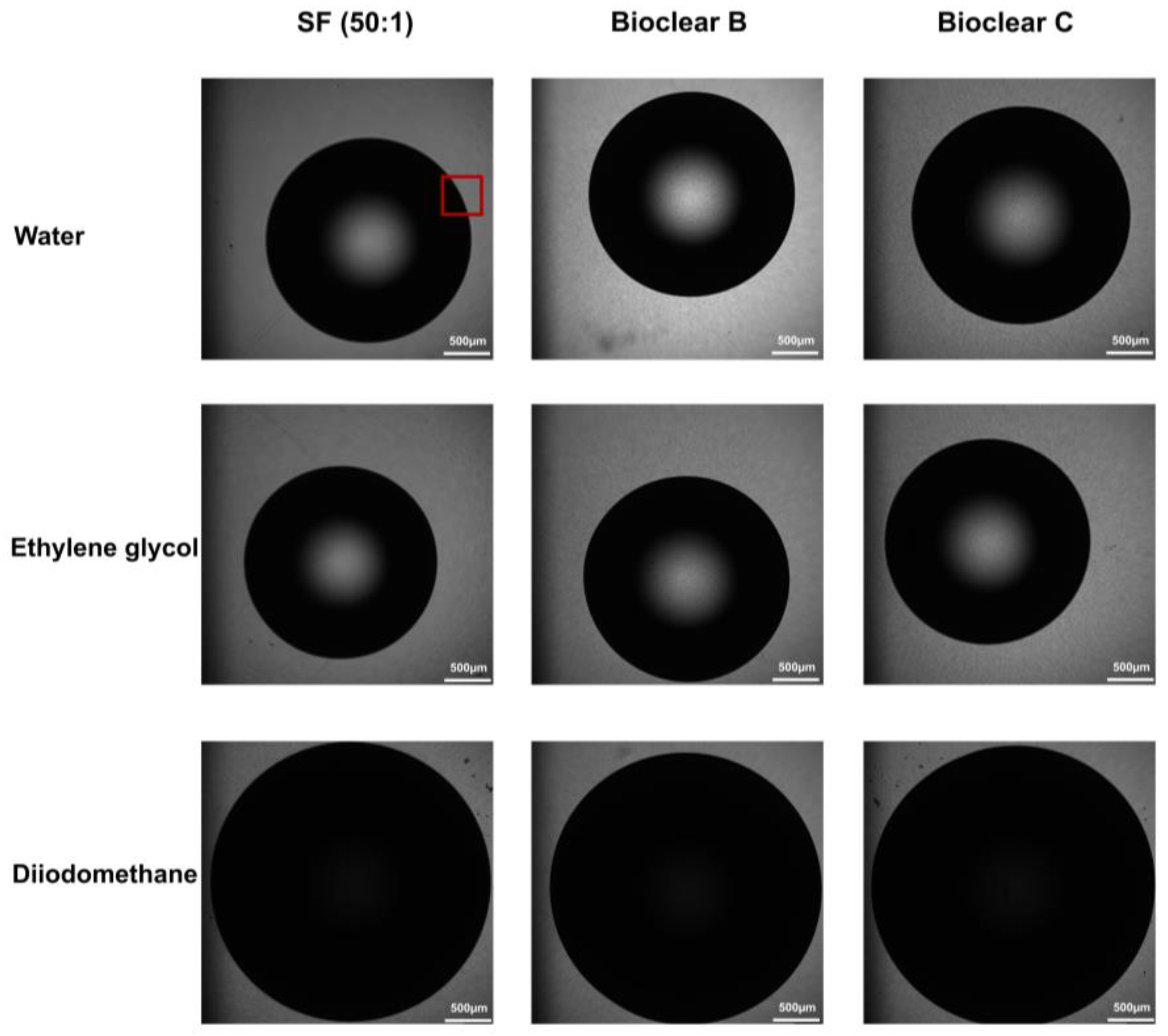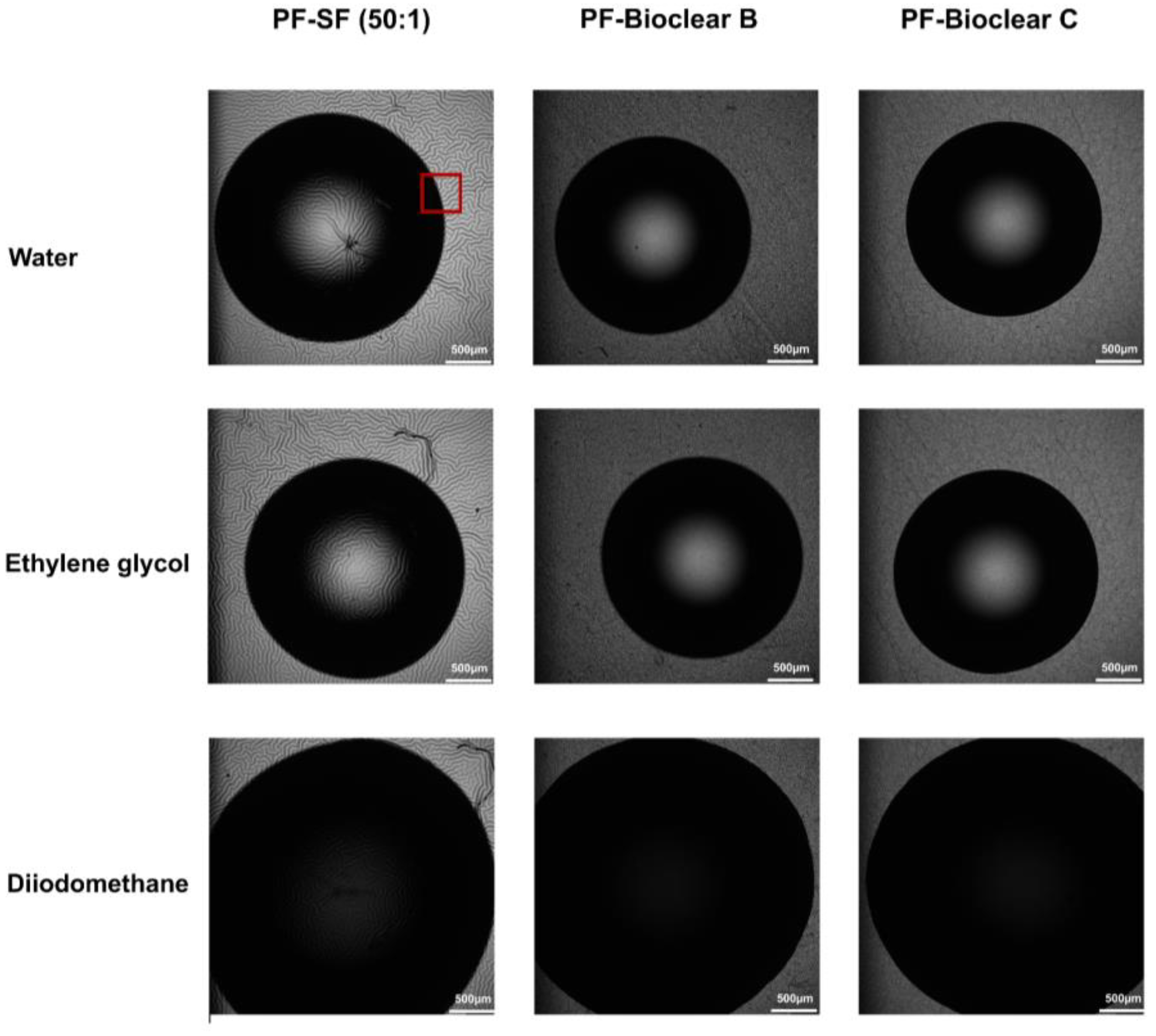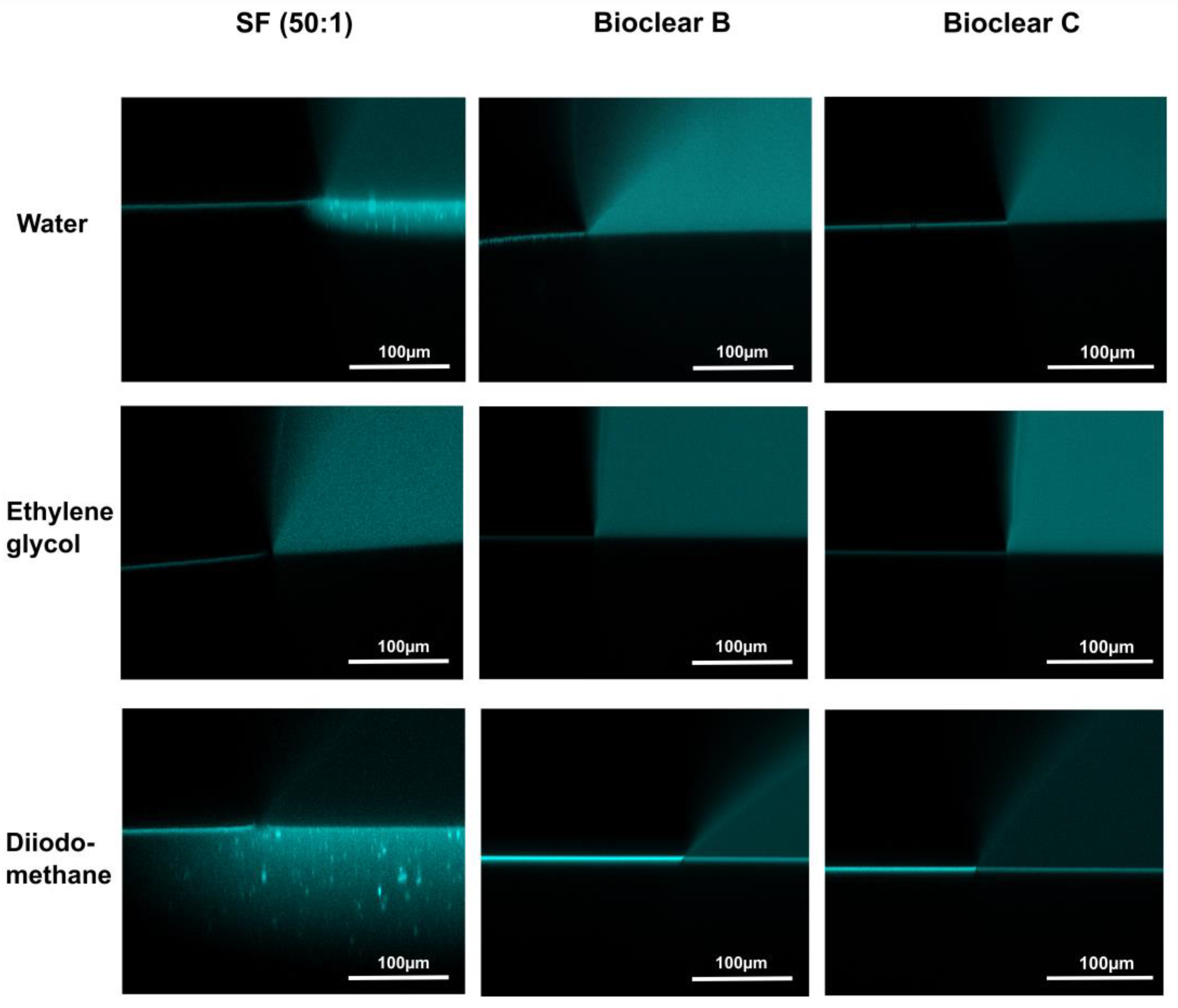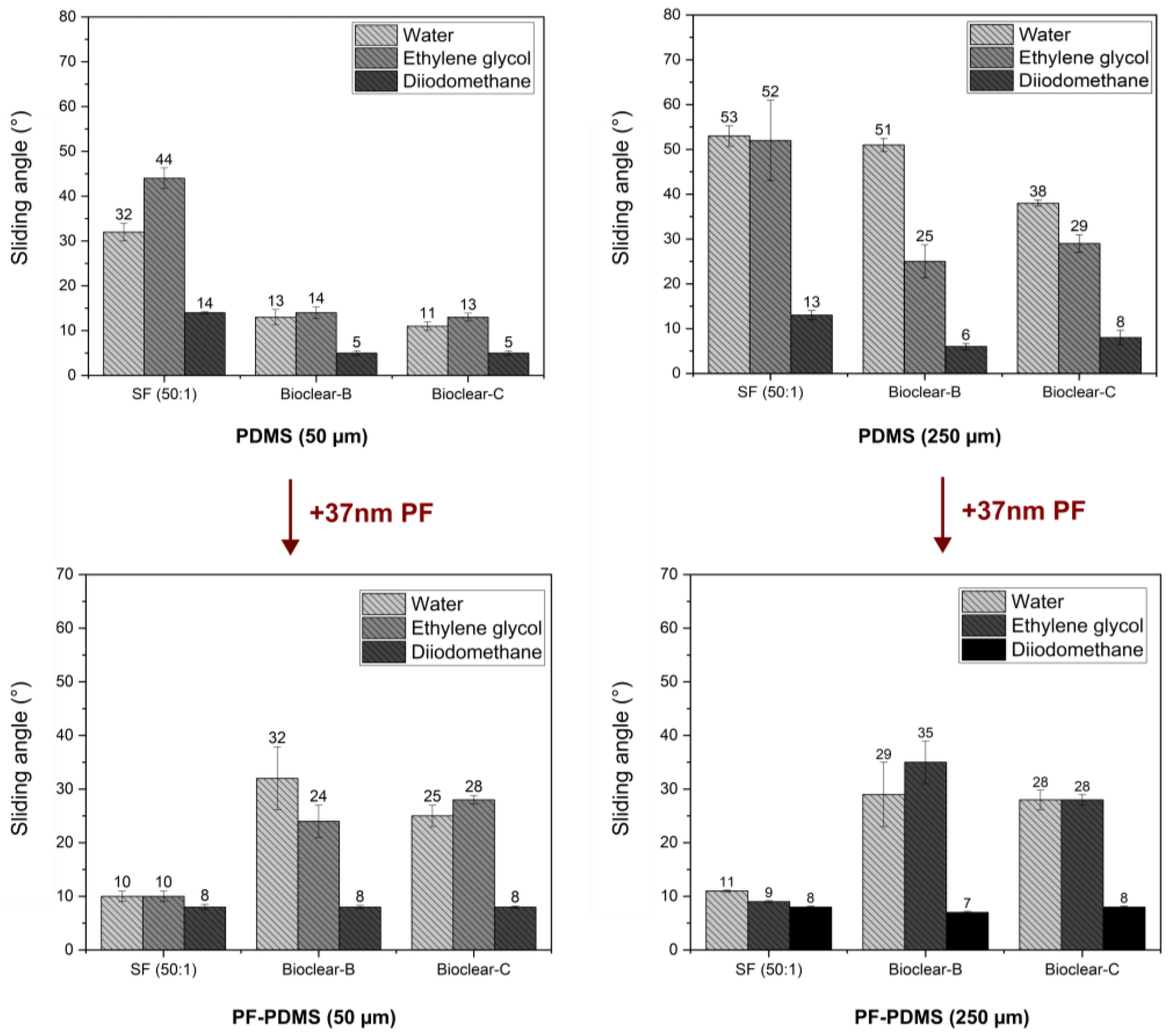Influence of Parylene F Coatings on the Wetting Properties of Soft Polydimethylsiloxane (PDMS)
Abstract
1. Introduction
2. Materials and Methods
2.1. Materials
2.2. Methods
3. Results
3.1. Soft PDMS Coatings and Free Oligomers
3.2. Wetting and Dewetting Behavior of Soft PDMS Substrates
3.3. Wetting Behavior of Parylene F Coated Soft PDMS
4. Conclusions
Author Contributions
Funding
Institutional Review Board Statement
Informed Consent Statement
Data Availability Statement
Conflicts of Interest
Appendix A


| Water | Ethylene Glycol | Diiodomethane | |
|---|---|---|---|
| Total (mNm−1) | 72.8 | 48 | 50.8 |
| Polar (mNm−1) | 51 | 19 | 0 |
| Dispersive (mNm−1) | 21.8 | 29 | 50.8 |
| Thickness (µm) | SF | Bioclear B | Bioclear C | ||||||
|---|---|---|---|---|---|---|---|---|---|
| Water (°) | E.G (°) | D.I (°) | Water (°) | E.G (°) | D.I (°) | Water (°) | E.G (°) | D.I (°) | |
| 5 | 109 ± 2 | 94 ± 2 | 72 ± 2 | 105 ± 1 | 85 ± 1 | 71 ± 1 | 107 ± 1 | 84 ± 1 | 72 ± 1 |
| 15 | 110 ± 1 | 91 ± 2 | 71 ± 1 | 107 ± 1 | 85 ± 2 | 72 ± 2 | 105 ± 1 | 85 ± 1 | 70 ± 1 |
| 25 | 110 ± 1 | 90 ± 3 | 73 ± 1 | 106 ± 1 | 84 ± 1 | 70 ± 1 | 105 ± 1 | 85 ± 1 | 71 ± 1 |
| 50 | 111 ± 1 | 92 ± 3 | 74 ± 2 | 105 ± 1 | 86 ± 1 | 73 ± 1 | 105 ± 1 | 83 ± 1 | 71 ± 2 |
| 250 | 109 ± 1 | 94 ± 2 | 72 ± 2 | 106 ± 1 | 84 ± 2 | 70 ± 1 | 105 ± 1 | 84 ± 1 | 72 ± 2 |
| Thickness (µm) | SF (50:1) | Bioclear B | Bioclear C | ||||||
|---|---|---|---|---|---|---|---|---|---|
| Water (°) | E.G (°) | D.I (°) | Water (°) | E.G (°) | D.I (°) | Water (°) | E.G (°) | D.I (°) | |
| 5 | 31 ± 3 | 34 ± 3 | 20 ± 3 | 10 ± 2 | 10 ± 1 | 4 ± 2 | 11 ± 2 | 12 ± 3 | 4 ± 1 |
| 15 | 27 ± 4 | 33 ± 5 | 15 ± 3 | 11 ± 2 | 12 ± 1 | 6 ± 1 | 12 ± 2 | 11 ± 1 | 5 ± 1 |
| 25 | 33 ± 4 | 30 ± 4 | 12 ± 2 | 11 ± 2 | 12 ± 2 | 5 ± 1 | 11 ± 3 | 12 ± 2 | 4 ± 1 |
| 50 | 33 ± 3 | 34 ± 3 | 13 ± 3 | 12 ± 2 | 14 ± 2 | 5 ± 1 | 10 ± 1 | 11 ± 2 | 5 ± 1 |
| 250 | 54 ± 3 | 52 ± 8 | 14 ± 3 | 51 ± 5 | 25 ± 4 | 5 ± 1 | 35 ± 3 | 28 ± 3 | 8 ± 2 |

| PF Coating on a Glass Slide | |||
|---|---|---|---|
| Water | Ethylene Glycol | Diiodomethane | |
| CA (°) | 92 ± 3 | 66 ± 1 | 50 ± 1 |
| SA (°) | 36 ± 3 | 31 ± 3 | 9 ± 2 |
| Layer Thickness (µm) | Wrinkle Dimension Depth (µm) | Wrinkle Dimension Lateral (µm) | ||||
|---|---|---|---|---|---|---|
| SF (50:1) | Bioclear B | Bioclear C | SF (50:1) | Bioclear B | Bioclear C | |
| 50 | 1 ± 0 | 2 ± 1 | 2 ± 0 | 42 ± 8 | 14 ± 3 | 14 ± 6 |
| 250 | 2 ± 1 | 3 ± 1 | 3 ± 1 | 40 ± 8 | 13 ± 7 | 19 ± 8 |
| Thickness (µm) | SF | Bioclear B | Bioclear C | ||||||
|---|---|---|---|---|---|---|---|---|---|
| Water (°) | E.G (°) | D.I (°) | Water (°) | E.G (°) | D.I (°) | Water (°) | E.G (°) | D.I (°) | |
| 50 | 109 ± 1 | 84 ± 1 | 67 ± 1 | 110 ± 2 | 83 ± 1 | 61 ± 1 | 108 ± 2 | 82 ± 1 | 61 ± 0 |
| 250 | 108 ± 1 | 84 ± 1 | 68 ± 2 | 108 ± 1 | 83 ± 1 | 59 ± 0 | 109 ± 1 | 83 ± 0 | 60 ± 1 |
| Thickness (µm) | SF (50:1) | Bioclear B | Bioclear C | ||||||
|---|---|---|---|---|---|---|---|---|---|
| Water (°) | E.G (°) | D.I (°) | Water (°) | E.G (°) | D.I (°) | Water (°) | E.G (°) | D.I (°) | |
| 50 | 10 ± 1 | 10 ± 1 | 8 ± 1 | 32 ± 6 | 24 ± 3 | 8 ± 0 | 25 ± 2 | 28 ± 1 | 8 ± 0 |
| 250 | 11 ± 1 | 9 ± 1 | 8 ± 1 | 29 ± 6 | 35 ± 4 | 7 ± 0 | 28 ± 2 | 28 ± 1 | 8 ± 0 |


References
- Wang, J.; Wang, L.; Sun, N.; Tierney, R.; Li, H.; Corsetti, M.; Williams, L.; Wong, P.K.; Wong, T.-S. Viscoelastic Solid-Repellent Coatings for Extreme Water Saving and Global Sanitation. Nat. Sustain. 2019, 2, 1097–1105. [Google Scholar] [CrossRef]
- Bhattacharjee, N.; Parra-Cabrera, C.; Kim, Y.T.; Kuo, A.P.; Folch, A. Desktop-Stereolithography 3D-Printing of a Poly(Dimethylsiloxane)-Based Material with Sylgard-184 Properties. Adv. Mater. 2018, 30, 1800001. [Google Scholar] [CrossRef]
- Bonn, D.; Eggers, J.; Indekeu, J.; Meunier, J.; Rolley, E. Wetting and Spreading. Rev. Mod. Phys. 2009, 81, 739–805. [Google Scholar] [CrossRef]
- Carré, A.; Gastel, J.-C.; Shanahan, M.E.R. Viscoelastic Effects in the Spreading of Liquids. Nature 1996, 379, 432–434. [Google Scholar] [CrossRef]
- Long, D.; Ajdari, A.; Leibler, L. How Do Grafted Polymer Layers Alter the Dynamics of Wetting? Langmuir 1996, 12, 1675–1680. [Google Scholar] [CrossRef]
- Karpitschka, S.; Das, S.; van Gorcum, M.; Perrin, H.; Andreotti, B.; Snoeijer, J.H. Droplets Move over Viscoelastic Substrates by Surfing a Ridge. Nat. Commun. 2015, 6, 7891. [Google Scholar] [CrossRef]
- Park, S.J.; Bostwick, J.B.; Andrade, V.D.; Je, J.H. Self-Spreading of the Wetting Ridge during Stick-Slip on a Viscoelastic Surface. Soft Matter 2017, 13, 8331–8336. [Google Scholar] [CrossRef] [PubMed]
- Chakrabarti, A.; Porat, A.; Raphaël, E.; Salez, T.; Chaudhury, M.K. Elastowetting of Soft Hydrogel Spheres. Langmuir 2018, 34, 3894–3900. [Google Scholar] [CrossRef]
- Pu, G.; Severtson, S.J. Dependence of Wetting Behavior on the Thickness of Highly Viscoelastic Films. J. Phys. Chem. C 2011, 115, 18729–18735. [Google Scholar] [CrossRef]
- Pu, G.; Severtson, S.J. Characterization of Dynamic Stick-and-Break Wetting Behavior for Various Liquids on the Surface of a Highly Viscoelastic Polymer. Langmuir 2008, 24, 4685–4692. [Google Scholar] [CrossRef] [PubMed]
- Carta, R.; Jourand, P.; Hermans, B.; Thoné, J.; Brosteaux, D.; Vervust, T.; Bossuyt, F.; Axisa, F.; Vanfleteren, J.; Puers, R. Design and Implementation of Advanced Systems in a Flexible-Stretchable Technology for Biomedical Applications. Sens. Actuators A Phys. 2009, 156, 79–87. [Google Scholar] [CrossRef]
- Fujii, T. PDMS-Based Microfluidic Devices for Biomedical Applications. Microelectron. Eng. 2002, 61–62, 907–914. [Google Scholar] [CrossRef]
- Lovchik, R.D.; Wolf, H.; Delamarche, E. High-Grade Optical Polydimethylsiloxane for Microfluidic Applications. Biomed Microdevices 2011, 13, 1027–1032. [Google Scholar] [CrossRef] [PubMed]
- Chen, X.; Shen, J.; Hu, Z.; Huo, X. Manufacturing Methods and Applications of Membranes in Microfluidics. Biomed. Microdevices 2016, 18, 104. [Google Scholar] [CrossRef]
- Wong, W.S.Y.; Hauer, L.; Naga, A.; Kaltbeitzel, A.; Baumli, P.; Berger, R.; D‘Acunzi, M.; Vollmer, D.; Butt, H.-J. Adaptive Wetting of Polydimethylsiloxane. Langmuir 2020, 36, 7236–7245. [Google Scholar] [CrossRef]
- Cai, Z.; Skabeev, A.; Morozova, S.; Pham, J.T. Fluid Separation and Network Deformation in Wetting of Soft and Swollen Surfaces. Commun. Mater. 2021, 2, 1–11. [Google Scholar] [CrossRef]
- Hourlier-Fargette, A.; Antkowiak, A.; Chateauminois, A.; Neukirch, S. Role of Uncrosslinked Chains in Droplets Dynamics on Silicone Elastomers. Soft Matter 2017, 13, 3484–3491. [Google Scholar] [CrossRef]
- Shin, Y.S.; Cho, K.; Lim, S.H.; Chung, S.; Park, S.-J.; Chung, C.; Han, D.-C.; Chang, J.K. PDMS-Based Micro PCR Chip with Parylene Coating. J. Micromech. Microeng. 2003, 13, 768. [Google Scholar] [CrossRef]
- Senkevich, J.J.; Wang, P.-I. Molecular Layer Chemistry via Parylenes. Chem. Vap. Depos. 2009, 15, 91–94. [Google Scholar] [CrossRef]
- Cieślik, M.; Kot, M.; Reczyński, W.; Engvall, K.; Rakowski, W.; Kotarba, A. Parylene Coatings on Stainless Steel 316L Surface for Medical Applications—Mechanical and Protective Properties. Mater. Sci. Eng. C 2012, 32, 31–35. [Google Scholar] [CrossRef]
- Cieślik, M.; Engvall, K.; Pan, J.; Kotarba, A. Silane–Parylene Coating for Improving Corrosion Resistance of Stainless Steel 316L Implant Material. Corros. Sci. 2011, 53, 296–301. [Google Scholar] [CrossRef]
- Kim, B.J.; Meng, E. Micromachining of Parylene C for BioMEMS. Polym. Adv. Technol. 2016, 27, 564–576. [Google Scholar] [CrossRef]
- Noh, H.-S.; Huang, Y.; Hesketh, P.J. Parylene Micromolding, a Rapid and Low-Cost Fabrication Method for Parylene Microchannel. Sens. Actuators B Chem. 2004, 102, 78–85. [Google Scholar] [CrossRef]
- Sasaki, H.; Onoe, H.; Osaki, T.; Kawano, R.; Takeuchi, S. Parylene-Coating in PDMS Microfluidic Channels Prevents the Absorption of Fluorescent Dyes. Sens. Actuators B Chem. 2010, 150, 478–482. [Google Scholar] [CrossRef]
- Wu, P.K.; Yang, G.-R.; You, L.; Mathur, D.; Cocoziello, A.; Lang, C.-I.; Moore, J.A.; Lu, T.-M.; Bakru, H. Deposition of High Purity Parylene- F Using Low Pressure Low Temperature Chemical Vapor Deposition. J. Electron. Mater. 1997, 26, 949–953. [Google Scholar] [CrossRef]
- Martini, D.; Shepherd, K.; Sutcliffe, R.; Kelber, J.; Edwards, H.; San Martin, R. Modification of Parylene AF-4 Surfaces Using Activated Water Vapor. Appl. Surf. Sci. 1999, 141, 89–100. [Google Scholar] [CrossRef]
- Kahouli, A.; Sylvestre, A.; Jomni, F.; André, E.; Garden, J.-L.; Yangui, B.; Berge, B.; Legrand, J. Dielectric Properties of Parylene AF4 as Low-k Material for Microelectronic Applications. Thin Solid Film. 2012, 520, 2493–2497. [Google Scholar] [CrossRef]
- Kahouli, A.; Sylvestre, A.; Laithier, J.-F.; Lutsen, L.; Pairis, S.; André, E.; Garden, J.-L. Structural and Dielectric Properties of Parylene-VT4 Thin Films. Mater. Chem. Phys. 2014, 143, 908–914. [Google Scholar] [CrossRef]
- Akhtar, M.; van den Driesche, S.; Bödecker, A.; Vellekoop, M.J. Long-Term Storage of Droplets on a Chip by Parylene AF4 Coating of Channels. Sens. Actuators B Chem. 2018, 255, 3576–3584. [Google Scholar] [CrossRef]
- Bellaredj, M.L.F.; Andrianov, N.; Kaufhold, R.; Miskovic, G. Soft Mask-Based Dry Etching of Parylene AF4 for Advanced Packaging Applications. In Proceedings of the 2022 IEEE 24th Electronics Packaging Technology Conference (EPTC), Singapore, 7–9 December 2022; pp. 109–113. [Google Scholar]
- Desai, C.; Laube, N. Development of a Technical Approach to Modify the Internal Surface of Biomedical Tubes and Other Elongated Small Lumen Macrodevices with Parylene Coating. J. Coat. Technol. Res. 2019, 16, 103–111. [Google Scholar] [CrossRef]
- Han, B.; Wang, P.; Jin, H.; Hou, Z.; Bai, X. Wettability and Surface Energy of Parylene F Deposited on PDMS. Phys. Lett. A 2020, 384, 126628. [Google Scholar] [CrossRef]
- Tian, L.; Yin, Y.; Zhao, J.; Jin, H.; Shang, Y.; Yan, S.; Dong, S. Parylene F Coatings for Combating Marine Biofouling. Mater. Lett. 2021, 285, 129141. [Google Scholar] [CrossRef]
- Karakurt, I.; Zhong, J.; Lin, L. 3D Printed Flexible Triboelectric Energy Harvesters via Conformal Coating of Parylene AF4. In Proceedings of the 2019 IEEE 32nd International Conference on Micro Electro Mechanical Systems (MEMS), Seoul, Republic of Korea, 27–31 January 2019; pp. 954–957. [Google Scholar]
- Sutcliffe, R.; Lee, W.W.; Gaynor, J.F.; Luttmer, J.D.; Martini, D.; Kelber, J.; Plano, M.A. Characterization and Aluminum Metallization of a Parylene AF-4 Surface. Appl. Surf. Sci. 1998, 126, 43–56. [Google Scholar] [CrossRef]
- Ye, H.; Kwon, H.; Tang, X.; Park, C.E.; An, T.K.; Kim, S.H. Parylene-Based Polymeric Dielectric Top-Gate Organic Field-Effect Transistors Exposed to a UV/Ozone Environment. Org. Electron. 2020, 87, 105942. [Google Scholar] [CrossRef]
- Mayoussi, F.; Usama, A.; Karimi, K.; Nekoonam, N.; Goralczyk, A.; Zhu, P.; Helmer, D.; Rapp, B.E. Superrepellent Porous Polymer Surfaces by Replication from Wrinkled Polydimethylsiloxane/Parylene F. Materials 2022, 15, 7903. [Google Scholar] [CrossRef]
- Lee, J.N.; Park, C.; Whitesides, G.M. Solvent Compatibility of Poly(Dimethylsiloxane)-Based Microfluidic Devices. Anal. Chem. 2003, 75, 6544–6554. [Google Scholar] [CrossRef]
- Owen, M.J. Low Surface Energy Inorganic Polymers. Comments Inorg. Chem. 1988, 7, 195–213. [Google Scholar] [CrossRef]
- Wang, J.; Shi, F.G.; Nieh, T.G.; Zhao, B.; Brongo, M.R.; Qu, S.; Rosenmayer, T. Thickness Dependence of Elastic Modulus and Hardness of On-Wafer Low-k Ultrathin Polytetrafluoroethylene Films. Scr. Mater. 2000, 42, 687–694. [Google Scholar] [CrossRef]
- Liu, M.; Sun, J.; Sun, Y.; Bock, C.; Chen, Q. Thickness-Dependent Mechanical Properties of Polydimethylsiloxane Membranes. J. Micromech. Microeng. 2009, 19, 035028. [Google Scholar] [CrossRef]
- Wooh, S.; Vollmer, D. Silicone Brushes: Omniphobic Surfaces with Low Sliding Angles. Angew. Chem. Int. Ed. 2016, 55, 6822–6824. [Google Scholar] [CrossRef]
- Wang, L.; McCarthy, T.J. Covalently Attached Liquids: Instant Omniphobic Surfaces with Unprecedented Repellency. Angew. Chem. Int. Ed. 2016, 55, 244–248. [Google Scholar] [CrossRef] [PubMed]
- Liu, J.; Sun, Y.; Zhou, X.; Li, X.; Kappl, M.; Steffen, W.; Butt, H.-J. One-Step Synthesis of a Durable and Liquid-Repellent Poly(Dimethylsiloxane) Coating. Adv. Mater. 2021, 33, 2100237. [Google Scholar] [CrossRef] [PubMed]
- Chen, L.; Bonaccurso, E.; Deng, P.; Zhang, H. Droplet Impact on Soft Viscoelastic Surfaces. Phys. Rev. E 2016, 94, 063117. [Google Scholar] [CrossRef] [PubMed]
- Mangili, S.; Antonini, C.; Marengo, M.; Amirfazli, A. Understanding the Drop Impact Phenomenon on Soft PDMS Substrates. Soft Matter 2012, 8, 10045–10054. [Google Scholar] [CrossRef]
- Trantidou, T.; Payne, D.J.; Tsiligkiridis, V.; Chang, Y.-C.; Toumazou, C.; Prodromakis, T. The Dual Role of Parylene C in Chemical Sensing: Acting as an Encapsulant and as a Sensing Membrane for PH Monitoring Applications. Sens. Actuators B Chem. 2013, 186, 1–8. [Google Scholar] [CrossRef]
- Birbarah, P.; Gebrael, T.; Foulkes, T.; Stillwell, A.; Moore, A.; Pilawa-Podgurski, R.; Miljkovic, N. Water Immersion Cooling of High Power Density Electronics. Int. J. Heat Mass Transf. 2020, 147, 118918. [Google Scholar] [CrossRef]






| PDMS Substrates | SF (50:1) | Bioclear-B | Bioclear-C |
|---|---|---|---|
| E-modulus (kPa) | 7 ± 0.2 | 56 ± 6 | 15 ± 1 |
Disclaimer/Publisher’s Note: The statements, opinions and data contained in all publications are solely those of the individual author(s) and contributor(s) and not of MDPI and/or the editor(s). MDPI and/or the editor(s) disclaim responsibility for any injury to people or property resulting from any ideas, methods, instructions or products referred to in the content. |
© 2023 by the authors. Licensee MDPI, Basel, Switzerland. This article is an open access article distributed under the terms and conditions of the Creative Commons Attribution (CC BY) license (https://creativecommons.org/licenses/by/4.0/).
Share and Cite
Mayoussi, F.; Usama, A.; Nekoonam, N.; Knauer, I.; Böcherer, D.; Rapp, B.E.; Helmer, D. Influence of Parylene F Coatings on the Wetting Properties of Soft Polydimethylsiloxane (PDMS). Materials 2023, 16, 1938. https://doi.org/10.3390/ma16051938
Mayoussi F, Usama A, Nekoonam N, Knauer I, Böcherer D, Rapp BE, Helmer D. Influence of Parylene F Coatings on the Wetting Properties of Soft Polydimethylsiloxane (PDMS). Materials. 2023; 16(5):1938. https://doi.org/10.3390/ma16051938
Chicago/Turabian StyleMayoussi, Fadoua, Ali Usama, Niloofar Nekoonam, Ivonne Knauer, David Böcherer, Bastian E. Rapp, and Dorothea Helmer. 2023. "Influence of Parylene F Coatings on the Wetting Properties of Soft Polydimethylsiloxane (PDMS)" Materials 16, no. 5: 1938. https://doi.org/10.3390/ma16051938
APA StyleMayoussi, F., Usama, A., Nekoonam, N., Knauer, I., Böcherer, D., Rapp, B. E., & Helmer, D. (2023). Influence of Parylene F Coatings on the Wetting Properties of Soft Polydimethylsiloxane (PDMS). Materials, 16(5), 1938. https://doi.org/10.3390/ma16051938






